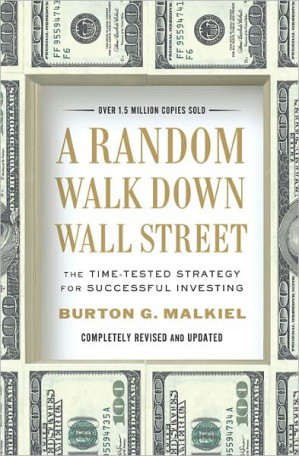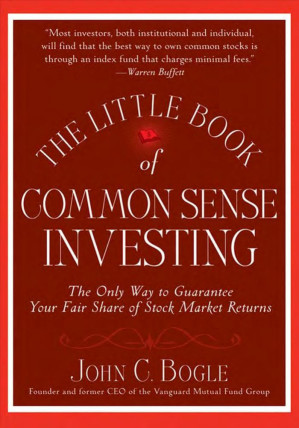Stock prices follow a random walk—past performance doesn't predict future results.
Malkiel demonstrates that stock price movements are largely unpredictable and resemble a random walk.

Book summary
by Burton G. Malkiel
The time-tested strategy for successful investing
Time-tested strategy using random walk theory for investing
Topics
Read this book as a practical guide to evidence-based investing rather than theoretical finance. Focus on Malkiel's arguments against market timing and stock picking, and his case for index funds. Pay special attention to the behavioral finance sections that explain why investors make emotional mistakes. The book builds logically from theory to practical portfolio construction—read sequentially for maximum understanding.
Things to know before reading
This investment classic argues that stock prices follow random patterns and cannot be consistently predicted. Understanding basic financial concepts like diversification and compound interest will help, but the book explains everything clearly. Malkiel's evidence comes from decades of market data showing that most active managers fail to beat the market after fees. Be prepared to question common investment wisdom.
A Random Walk Down Wall Street presents the revolutionary idea that stock prices follow a random pattern and cannot be predicted in the short term. Burton Malkiel argues that most active investment strategies fail to beat simple index funds over time, making passive investing the most reliable path to wealth accumulation for individual investors.
Malkiel's random walk theory dismantles Wall Street's active management myths while offering a simple, evidence-based alternative.
Malkiel demonstrates that stock price movements are largely unpredictable and resemble a random walk.
Over 15-year periods, 85% of actively managed funds fail to beat their benchmark index.
Investors consistently buy high and sell low due to emotional decision-making.
Ready to continue? Launch the Readever reader and keep turning pages without paying a cent.

John C. Bogle
Vanguard founder's guide to low-cost index fund strategy

Benjamin Graham
Definitive value investing guide emphasizing safety margins

Morgan Housel
Timeless lessons on wealth, greed, and happiness through psychology
This summary gives you the confidence to ignore market timing and stock picking in favor of low-cost index funds. You'll learn why professional money managers rarely outperform the market and how to build a diversified portfolio that grows steadily over decades.
Key idea 1
Malkiel demonstrates that stock price movements are largely unpredictable and resemble a random walk.
The core concept of random walk theory holds that stock prices incorporate all available information, making future price movements unpredictable. Technical analysis and chart patterns become useless because past price data contains no predictive power. Malkiel supports this with extensive research showing that professional money managers consistently fail to beat market indexes over the long term.
Remember
Key idea 2
Over 15-year periods, 85% of actively managed funds fail to beat their benchmark index.
Malkiel presents compelling evidence that low-cost index funds deliver superior returns compared to actively managed funds. The combination of lower fees, broader diversification, and reduced trading costs gives index funds a significant advantage. He shows how compounding these small advantages over decades creates substantial wealth differences.
Remember
Key idea 3
Investors consistently buy high and sell low due to emotional decision-making.
Malkiel explores how psychological factors like overconfidence, herd mentality, and loss aversion lead investors to make costly mistakes. He shows that successful investing requires overcoming these natural tendencies through disciplined, systematic approaches rather than emotional reactions to market movements.
Remember
A Random Walk Down Wall Street is a comprehensive guide to investing that combines financial theory, historical evidence, and practical advice. First published in 1973 and updated through multiple editions, the book has become a classic in investment literature.
Malkiel systematically debunks popular investment strategies like technical analysis, fundamental analysis, and market timing, showing that they fail to deliver consistent results. Instead, he advocates for a simple, passive approach centered around low-cost index funds. The book covers everything from basic investment principles to advanced portfolio construction, making complex financial concepts accessible to individual investors.
Open Readever's reader to highlight passages, ask the AI companion questions, and keep exploring without paying a cent.
Malkiel's writing combines academic rigor with practical wisdom, making complex financial theories accessible to everyday investors. His arguments are backed by decades of market data and economic research, presented in a clear, engaging style that avoids technical jargon. The book's enduring popularity stems from its timeless principles and evidence-based approach to investing.
Critical Reception: A Random Walk Down Wall Street has sold over 1.5 million copies and been translated into multiple languages. It has been praised by Nobel laureates including Paul Samuelson and featured in publications like The Wall Street Journal and The New York Times as essential reading for investors. The book's predictions about the superiority of index funds have been validated by decades of subsequent market performance.
Individual investors tired of trying to beat the market
Anyone starting their investment journey
People overwhelmed by complex financial advice
Investors seeking evidence-based strategies
Those wanting to understand why most active management fails
Burton Gordon Malkiel is an American economist, financial executive, and writer best known for A Random Walk Down Wall Street. Born in 1932, he earned his PhD from Princeton University and has served as the Chemical Bank Chairman's Professor of Economics at Princeton since 1975.
Malkiel has held numerous prestigious positions including Dean of the Yale School of Management, member of the Council of Economic Advisers under President Gerald Ford, and director of several major financial institutions. His research focuses on financial markets, investment strategies, and behavioral finance. Beyond his academic work, Malkiel has served on the boards of Vanguard and other investment companies, giving him practical insight into the investment industry.
His work has influenced generations of investors and helped popularize index fund investing long before it became mainstream.
Build your personalized reading stack
Download full-length ePubs in one click with personal cloud storage.
Blend AI-guided insights with tactile note-taking to accelerate reflection.
Follow curated reading journeys tailored to your goals and time budget.
Sync highlights across devices so lessons stick beyond the page.
Sign in to Readever to keep reading with AI guidance, instant summaries, and synced notes.
A Random Walk Down Wall Street proves that simplicity beats complexity in investing. Malkiel's evidence shows that trying to outsmart the market through active management is a losing game for most investors. Instead, he offers a clear path to wealth accumulation through low-cost index funds, disciplined saving, and long-term thinking. The book's enduring message is that successful investing requires patience, not prediction.
Malkiel provides fascinating historical analysis of market bubbles, demonstrating how irrational exuberance has repeated throughout financial history:
These historical examples reinforce Malkiel's argument that markets are prone to irrational behavior, making prediction unreliable.
Malkiel's work is closely associated with the Efficient Market Hypothesis (EMH), which comes in three forms:
While Malkiel acknowledges that markets aren't perfectly efficient, he argues they're efficient enough that active management can't consistently beat them after costs.
Malkiel provides specific recommendations for portfolio construction based on age and risk tolerance:
He emphasizes the importance of global diversification, recommending 20-40% of equity allocation to international markets to reduce country-specific risk.
Malkiel includes real estate investment trusts (REITs) as part of a diversified portfolio, typically suggesting 5-10% allocation.
Malkiel was ahead of his time in discussing behavioral biases that affect investment decisions:
Malkiel's most enduring contribution is his strong advocacy for index funds:
While first published in 1973, Malkiel's principles remain highly relevant:
Malkiel addresses common criticisms of his approach:
This extended outline captures the most practical applications of Malkiel's timeless investment wisdom, providing readers with actionable strategies for building wealth through disciplined, evidence-based investing.
Start reading A Random Walk Down Wall Street for free and unlock personalized book journeys with Readever.